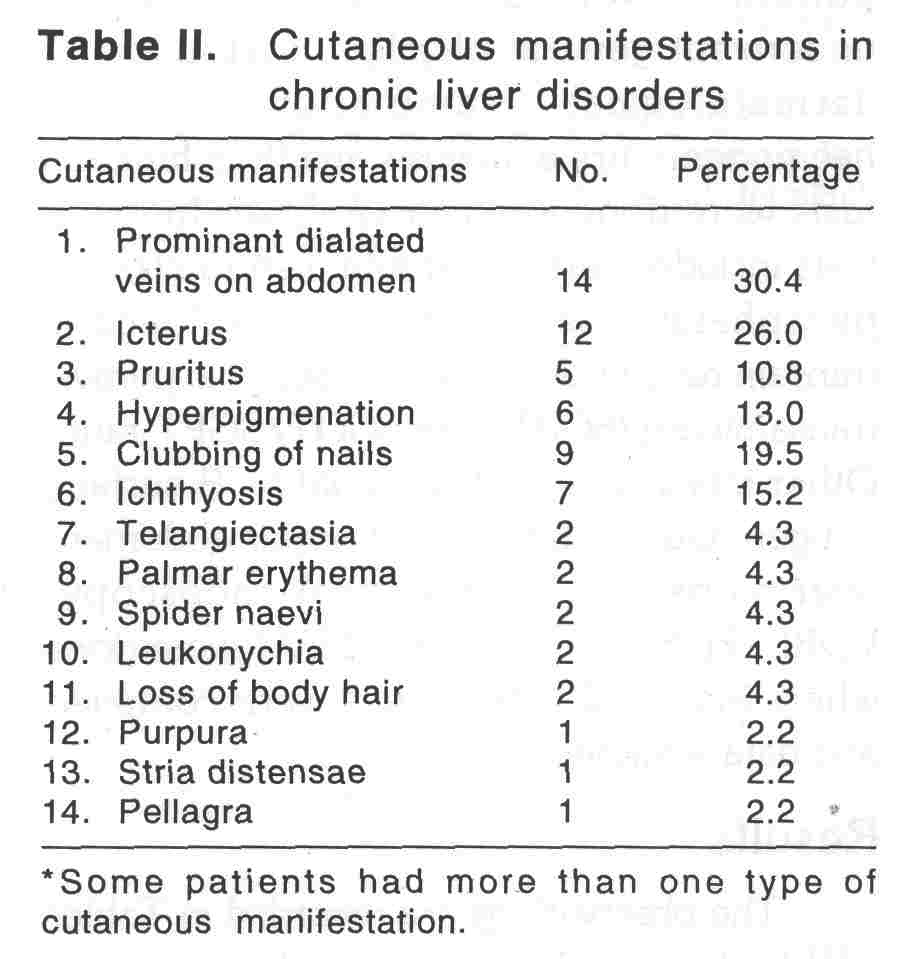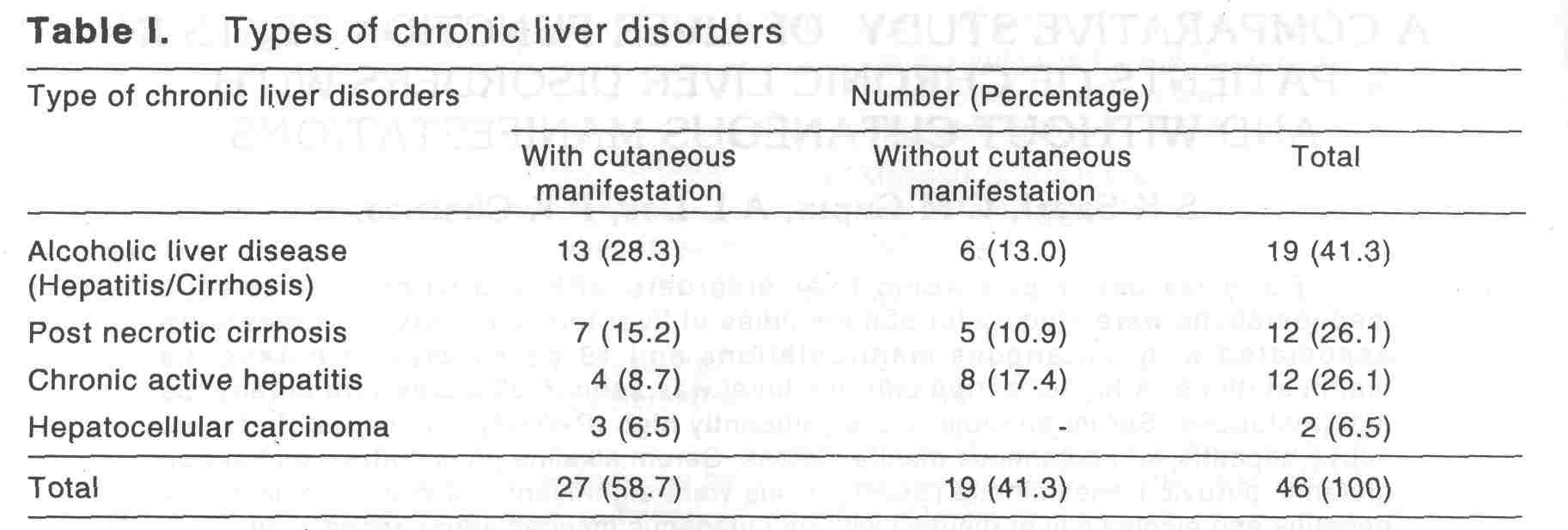Translate this page into:
A comparative study of liver function tests in patients of chronic liver disorders with and without cutaneous manifestations
Correspondence Address:
S K Sayal
Department of Dermatology and Venereology, AFMC, Pune-411040
India
| How to cite this article: Sayal S K, Gupta C M, Das A L, Chattwal P K. A comparative study of liver function tests in patients of chronic liver disorders with and without cutaneous manifestations. Indian J Dermatol Venereol Leprol 1997;63:15-19 |
Abstract
Forty six cases of chronic liver disorders with and without cutaneous manifestations were studied for abnormalities of liver function tests. 27 cases were associated with cutaneous manifestations and 19 cases without cutaneous manifestations. A higher serum bilirubin level was seen in all cases with cutaneous manifestations. Serum bilirubin was significantly high (P<0.05) in patients of chronic active hepatitis with cutaneous manifestations. Serum alkaline phosphatase and serum glutamic pyruvic transaminase (SGPT) levels were significantly high in chronic active hepatitis and alcoholic liver disease without cutaneous manifestations respectively.















Introduction
The liver disease are frequently associated with abnormalities of skin and its appandages and as a general rule cutaneous findings are nonspecific as they may be present in other disease and absent in patients with advanced liver dysfunction.[1] However, many cutaneous manifestations are secondary to intrinsic liver disorders like pigmentary changes, vascular changes and some endocrine changes.[2] The abonormalities of other liver function tests in chronic liver disorder has also been studied by some workers.[3],[4] To the best of our knowledge we have not come across any comparative study of liver function tests in chronic liver diseases with and without cutaneous manifestations. We, therefore, made an attempt to study common liver function tests in chronic liver disorders with or without cutaneous manifestations.
Materials and Methods
The material for the study consisted of 46 cases of chronic liver disorders admitted in medical wards and gastroenterology centre of Command Hospital, Southern Command, Pune during the period from Mar 94 to Feb 95. Detailed history was recorded in each patient and in addition each patient underwent general physical, systemic and dermatological examination. Routine haemogram, urine analysis and liver function tests were done in all cases. Liver function tests included serum bilirubin, serum alkaline phosphatase, serum glutamic oxaloacetic transaminase (SGOT), serum glutamic pyruvic transaminase (SGPT) and SGOT/SGPT ratio. Other investigations like hepatitis B surface antigen, ultrasonography of upper abdomen, liver biopsy, gastrointestinal endoscopy, VDRL, ELISA for HIV1 and HIV2 were done where indicated. The results were compiled and data analysed.
Results
The observations are recorded in [Table - 1]-[Table - 8]. A total 46 cases of chronic liver disorders were taken for study. Out of this 46 cases, 19 were having alcoholic liver disease (hepatitis/cirrhosis), 12 post necrotic cirrhosis, 12 chronic active hepatitis and 3 hepatocellular carcinoma. Cutaneous manifestations were seen in 27 (58.7%) cases. These included 13 (28.3%) cases of alcoholic liver disease, 7 (15.2%) cases of post necrotic cirrhosis, 4 (8.7%) cases of chronic active hepatitis and 3 (6.5%) cases of hepatocellular carcinoma. Common cutaneous manifestations seen in chronic liver disorders [Table - 2] were prominent dilated veins in abdomen (30.4%), icterus (26.0%), clubbing of nails (19.5%), ichthyosis (15.2%), hyperpigmentation (13%) and pruritus (10.8%). Other less common cutaneous manifestations were telangectasia, palmar erythema, spider naevi, leukonychia and loss of body hair in 4.3% cases each and purpura, stria distensae and pellagra in 2.2% cases each.
The analysis of liver function tests showed a relatively high level of serum bilirubin [Table - 3] in chronic liver disorders with cutaneous manifestations. The level of serum bilirubin was significantly high (p<0.05) in patients of chronic active hepatitis having cutaneous manifestations as compared to similar patients without cutaneous manifestations.
The serum alkaline phosphatase level [Table - 4] was found low in all cases of chronic liver disorders with cutaneous manifestations as compared with those without cutaneous manifestations. The SGOT level [Table - 5] was also found low in cases of chronic liver disorder with cutaneous manifestation as compared to these without cutaneous manifestation. This difference was significant (P<0.05) in cases of chronic active hepatitis. The SGPT level [Table - 6] was also low in cases of chronic liver disorders with cutaneous manifestation as compared to those without cutaneous manifestation. This difference was significant (P<0.05) in cases of alcoholic liver disease. The SGOT/SGPT ratio [Table - 7] was more than 1 in all cases of chronic liver disorder and there was no difference in this ratio in both groups. This SGOPT/SGPT ratio was higher in patients of alcoholic liver disease.
Discussion
The cutaneous changes in hepatic disorders may be secondary to intrinsic liver disorders or metabolic enzyme deficiencies or may be miscellaneous association.[2] The cutaneous manifestations secondary to intrinsic liver disorder include jaundice, hypermelanosis, leukonychia, spider angioma, palmar erythema, loss of secondary male hair growth, stria, acne etc. Some of these disorders are clearly related with severity of liver dysfunction especially icterus which becomes clinically apparent when serum bilirubin level is in excess of 2.5 mg%.[2] The similar correlation between pruritus and high bilirubin level in serum could not be established.
The resutls of present study reveal that in chronic liver disorders, there was mild to moderate derangement of liver function. The values of serum bilirubin and serum alkaline phosphatase were moderately high in almost all cases while SGOT and SGPT levels remained within normal limits in majority of cases except in alcoholic liver disease. All the cases who had icterus had serum bilirubin level more than 2.5mgm% while serum bilirubin in nonicteric patients was less than 2.5mgm%
Almost any disorder affecting the liver may cause moderate increase in serum alkaline Phosphatase and this is attributed to increased liver enzyme in serum.[3] In our study also serum alkaline Phosphatase was elevated in almost all case of chronic liver disorder and surprisingly the elevation was more in cases without cutaneous manifestations as compared to chronic liver disorders with cutaneous manifestations. The reason for such difference is not understood. The serum SGOT and SGPT level was more than 40 iu/L in almost all cases of alcoholic liver disease and 2 cases of post necrotic cirrhosis. In all other cases of chronic liver disorder, the level of SGOT and SGPT was normal. The present study also revealed that SGOT/SGPT ratio provides useful information in diagnosis of chronic liver disorder especially alchoholic liver disease. We found mean SGOT/SGPT ratio of 1.45 in alcoholic liver disease and 1.3 in post necrotic cirrhosis. Jerold and Marshall[4] observed mean SGOT/SGPT level of 1.9 in their study. They found SGOT/SGPT ratio of more than 1 in 92% cases of alcoholic liver disease as compared to 84% cases in our study, 70% cases of post necrotic cirrhosis as compared to 83% in our study and 50% cases of chronic active hepatitis as compared to 58% cases in our study [Table - 8]. No difference was observed in SGOT/SGPT ratio in chronic liver disorders with or without cutaneous manifestations.
To conclude, we ovserved mild to moderate derangement of liver function in chronic liver disorders. The serum bilirubin level was high in patients with cutaneous manifestations while the level of serum alkaline phosphatase and serum glutamic pyruvic transaminase were high in patients of chronic liver disorder without cutaneous manifestation. It will be worthwhile to have such study in large group of patients where such correlation could be established.
| 1. |
Roberts SOB, Weishmann K. The skin in systemic disease. In: Rook A, Wilkinson DS, Ebling FJC, Champion RH, Burton JL, editors. Textbook of dermatology. 4th edn. Bombay: Oxford University Press,1987:2343-74.
[Google Scholar]
|
| 2. |
Berman JE, Lamkin BC. Hepatic disease and the skin. Dermatologic Clinic 1989;7:435-48.
[Google Scholar]
|
| 3. |
Marshall MK. Alkaline Phosphatase. Gastroenterology 1972;62:452-68.
[Google Scholar]
|
| 4. |
Jerold AC, Marshall MK. The SGOT/SGPT-an indicator of alcoholic liver disease. Digestive Disease Sciences 1979;24:835-8.
[Google Scholar]
|





